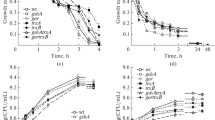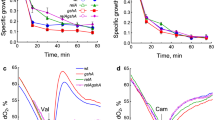Abstract
The growth of Escherichia coli mutants deficient in glutathione synthesis (gshA) and in glutathione reductase (gor) was suppressed in medium of elevated osmolarity. A mutant in γ-glutamyl transpeptidase (ggt) displayed better ability for osmoadaptation than the parental strain. The unfavorable effect of the gsh mutation on osmoadaptation of growing E. coli cells was more pronounced at low concentrations of K+ in the medium. An increase in osmolarity caused an increase in the intracellular content of glutathione. Changes in the extracellular glutathione level were biphasic: the glutathione level rapidly decreased during the first stage of the response and increased during the second stage. The changes in glutathione levels suggest that under hyperosmotic shock the glutathione transport from the medium into the cell can contribute to the intracellular glutathione accumulation. Changes in the level of intracellular K+ were similarly biphasic: a rapid increase in the K+ level during the first stage of the response to hyperosmotic shock changed to a gradual decrease during the second stage. In mutant gshA cells adapted to osmotic shock, the intracellular K+ level was markedly higher than in the parental strain cells. The possible role of glutathione in the response of E. coli to osmotic shock is discussed.
Similar content being viewed by others
REFERENCES
Wood, J. M. (1999) Microbiol.Mol.Biol.Rev., 63, 230–262.
Dinnbier, U., Limpinsel, E., Schmid, R., and Bakker, E. P. (1988) Arch.Microbiol., 150, 348–357.
Larsen, P. I., Sydnes, L. K., Landfald, B., and Str∅m, A. R. (1987) Arch.Microbiol., 147, 1–7.
Munro, G. F., Hercules, K., Morgan, J., and Sauerbier, W. (1972) J.Biol.Chem., 247, 1272–1280.
McLaggan, D., Logan, T. M., Lynn, D. G., and Epstein, W. (1990) J.Bacteriol., 172, 3631–3636.
Meury, J., and Kepes, A. (1982) EMBO J., 1, 339–343.
Smirnova, G. V., Muzyka, N. G., and Oktyabrsky, O. N. (2000) FEMS Microbiol.Lett., 186, 209–213.
Demple, B. (1991) Annu.Rev.Genet., 25, 315–337.
Smirnova, G. V., Muzyka, N. G., Glukhovchenko, M. N., and Oktyabrsky, O. N. (2000) Free Rad.Biol.Med., 28, 1009–1016.
Miller, J. H. (1972) Experiments in Molecular Genetics, Cold Spring Harbor, N. Y.
Tietze, F. (1969) Analyt.Biochem., 27, 502–522.
Alonso-Moraga, A., Bocanegra, A., Torres, J. M., López-Barea, J., and Pueyo, C. (1987) Mol.Cell.Biochem., 73, 61–68.
Lowry, O. H., Rosebrough, N. J., Farr, A. L., and Randall, R. J. (1951) J.Biol.Chem., 193, 265–275.
Becker-Hapak, M., and Eisenstark, A. (1995) FEMS Microbiol.Lett., 134, 39–44.
Hashimoto, W., Suzuki, H., Yamamoto, K., and Kumagai, H. (1997) Biosci.Biotech.Biochem., 61, 34–39.
Owens, R. A., and Hartman, P. E. (1986) J.Bacteriol., 168, 109–114.
Ohwada, T., and Sagisaka, S. (1988) Agric.Biol.Chem., 52, 313–319.
Oktyabrsky, O. N., and Smirnova, G. V. (1993) Biochem.Mol.Biol.Int., 30, 377–383.
Epstein, W., and Schultz, S. G. (1965) J.Gen.Physiol., 49, 221–234.
Measures, J. C. (1975) Nature, 257, 398–400.
Le Rudulier, D., Strøm, A. R., Dandekar, A. M., Smith, L. T., and Valentine, R. C. (1984) Science, 224, 1064–1068.
Tempest, D. W., Meers, J. L., and Brown, C. M. (1970) J.Gen.Microbiol., 64, 171–185.
Castle, A. M., Macnab, R. M., and Shulman, R. G. (1986) J.Biol.Chem., 261, 7797–7806.
Apontoweil, P., and Berends, W. (1975) Biochim.Biophys.Acta, 399, 1–9.
Suzuki, H., Kumagai, H., and Tochikura, T. (1987) J.Bacteriol., 169, 3926–3931.
Author information
Authors and Affiliations
Rights and permissions
About this article
Cite this article
Smirnova, G.V., Krasnykh, T.A. & Oktyabrsky, O.N. Role of Glutathione in the Response of Escherichia coli to Osmotic Stress. Biochemistry (Moscow) 66, 973–978 (2001). https://doi.org/10.1023/A:1012361323992
Issue Date:
DOI: https://doi.org/10.1023/A:1012361323992




